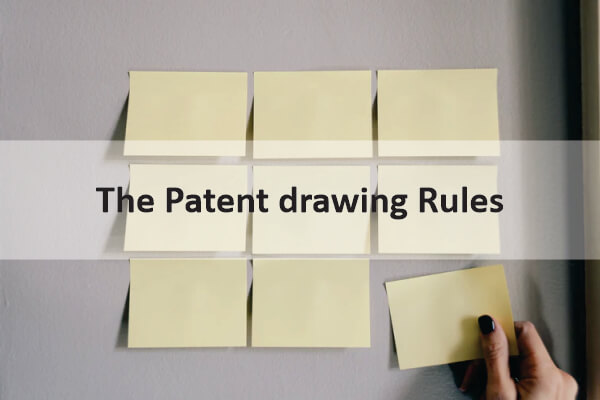A patent examiner looks for a descriptive patent illustration in a patent application. The examiner just needs to have a look at it. As a result, he may tell whether the illustrator has followed Patent drawing Rules or not. Patent drawing rules are guidelines that help patent illustrators in making patent illustrations. However, these guidelines may slightly vary depending on the country. Further, you may have a brilliant invention that you may want to patent. Therefore, you must know that a patent application is incomplete without a single patent drawing. No matter how descriptive your patent application is, it’s hard to understand an invention without a drawing. So in this article, we’ll see drawing guidelines and the importance of drawings in patent applications. Moreover, we’re going to see patent drawing rules set by the USPTO.
Related Article: Whom to Depend on for the Best Patent Illustration Services?
Patent Drawing Rules
The USPTO gets several patent applications every year. Therefore, it has an extensive list of patent drawing rules. These rules help a patent examiner as well as an applicant. When you follow patent drawing rules, the chances of your patent application getting rejected may reduce. Moreover, the patent drawings or illustrations must show each feature of the invention as mentioned in the claims. Also, the USPTO has defined three types of patents: Design, Plant, and Utility. Here are the USPTO patent drawing rules.
Drawing Requirements
Generally, applicants submit black and white drawings in patent applications. You must use unwrinkled drawing sheets. Moreover, there should no holes present in drawing sheets. Further, the dimensions of the drawings sheets should be 21.6 cm by 27.9 cm. Also, you can’t introduce a drawing necessary to understand the invention of the patent application after the filing date.
The Numbering of Sheets of Drawings and Views
You need to number drawing sheets using Arabic numerals starting with 1. So, you should put the numbers used for numbering in the middle of the top of the sheets. Moreover, the numbers used for numbering should be clear and understandable. Also, you need to give numbering to each drawing sheet in the following way – Page Number/Total Pages.
For instance, you’re at the 10th drawing sheet, and the total number of drawing sheets is 15. Then, you need to mention 10/15 on the 10th drawing sheet.
Moreover, you need to mention views with Arabic numerals too. Also, view numbers are independent of drawing sheet numbers. Moreover, you have to write “FIG” before viewing numbers. When there is a single view, needn’t write “FIG” and view number.
Reference Characters
You need to designate the parts of the invention with reference characters. Moreover, a part of an invention in different views should be mentioned with the same reference character. Also, the minimum height of the reference characters should be 0.32 cm.
Lead Lines and Arrows
Lead lines connect reference characters to details that reference characters refer to. One lead line needn’t intersect other lead lines. Moreover, they can be either straight or curved.
Besides lines, you may use arrows, but their meaning should be clear in drawings.
Identifications of Drawings
The title of the invention, the inventor’s name, the application number, and the docket number are used for identifications. In case when drawings and patent applications don’t match, the USPTO uses these identifications of drawings. Moreover, you may provide a name and telephone number to the USPTO.
Graphic Forms in Drawings
The USPTO perceives chemical or mathematical formulas, tables, computer program listings, and waveforms as drawings. Therefore, they need to follow patent drawing rules. Moreover, each chemical or mathematical formula is a figure.
So, concerning electrical signals, the horizontal axis act as time extending in a waveform. Moreover, you should show each group of waveforms in a single vertical and horizontal axis. Also, you need to designate each waveform with a letter.
Views
To make your invention easier to understand, you need to include as many views as you can. The following are the types of views defined by the USPTO.
- Exploded Views
- Partial Views
- Sectional Views
- Alternate Position
- Modified forms
Front Page View
You should display a view on the front page of your patent application. Moreover, you need to choose a suitable view that illustrates the invention perfectly.
Scale
The USPTO reproduces patent drawings in a reduced form. Therefore, patent drawings are drawn in such a way that they are visible in the two-third size of the original size.
Shading
You may use shading in patent illustrations. However, it shouldn’t interfere with the legibility of patent drawings. Moreover, shadings may help in understanding shapes in patent drawings.
Symbols
You may use universally recognized symbols in your drawings. However, it should not reduce the legibility and be irrelevant. Moreover, not universally recognized symbols may present in drawings. However, they shouldn’t make the drawings confusing.
Security Markings
Perhaps, you like to add security markings in your drawings. The USPTO allows applicants to introduce authorised security markings. However, you need to put it in the middle in the top margin.
Legends
On the approval of the USPTO, you may use descriptive legends. However, you need to make them short. Moreover, legends may increase the legibility of drawings.
Margins
Each drawing sheet containing drawings must have proper margins. Moreover, the usable surface on a drawing sheet mustn’t exceed 17.6 cm by 24.4 cm. The following are the minimum margins that patent illustrators must follow:
- top: 2.5 cm
- left side: 2.5 cm
- right side: 1.5 cm
- bottom: 1.0 cm
Colour Drawings
Generally, the USPTO receives patent applications comprising black and white drawings. However, in some cases, color drawings may present in a patent application. Moreover, there are additional guidelines to introduce color drawings in a patent application.
Related Article: A Detailed Insight on Patent Drawing Rules
The Importance of Patent Drawing
In the previous sections, we discussed the patent drawing rules. Through this article, we have got to know about the USTPO drawing requirements as well. Patent drawings are important, because an examiner may find the claims confusing without a drawing. Moreover, drawings are easier to understand. Also, drawings show the functionality or outer appearance of the invention. Therefore, an applicant must include drawings in his/her patent application. Moreover, we all know that a picture is worth a thousand words.
Related Article: Professional Patent Illustration Services
Follow the patent drawing rules with the Patent Illustration Express
Are you a person who is looking for a patent illustrator? Don’t search more as Patent Illustration Express (PIE) has a solution to your problem. PIE is a patent firm that has an experienced team of patent illustrators. Also, our patent illustrators comply with the USPTO patent drawing rules. Moreover, PIE has been serving clients from more than 45 countries. Further, patent illustrators at PIE are trained perfectly in making utility and designing patent illustrations. You may want to see the samples before making an order with us. You can get samples from here – samples. If you wish to see our affordable services, click here – Patent Illustration Express.
Other Related Articles:
Why Patent Drafting Services are Important?




